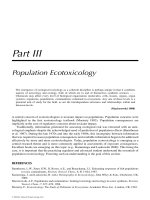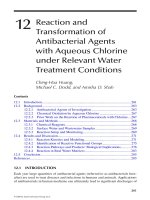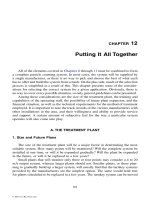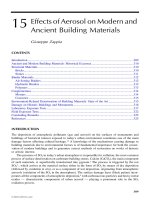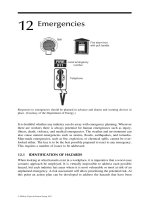INTERFACIAL APPLICATIONS IN ENVIRONMENTAL ENGINEERING - CHAPTER 12 pot
Bạn đang xem bản rút gọn của tài liệu. Xem và tải ngay bản đầy đủ của tài liệu tại đây (167.15 KB, 16 trang )
12
The Activity, Mechanism, and Effect of
Water as a Promoter of Uranium
Oxide Catalysts for Destruction of
Volatile Organic Compounds
STUART H. TAYLOR, RICHARD H. HARRIS, and GRAHAM J.
HUTCHINGS Cardiff University, Cardiff, United Kingdom
IAN D. HUDSON BNFL, Seascale, United Kingdom
I. INTRODUCTION
In recent years, concern for protection of the environment has increased, and
environmental legislation has imposed increasingly stringent targets for permitted
atmospheric emissions. In particular, the release of volatile organic compounds
(VOCs) has received much attention. Such VOCs represent a wide-ranging class
of chemicals derived from many sources and containing over 300 compounds as
designated by the U.S. Environmental Protection Agency [1]. Their release has
widespread environmental implications and has been linked to the increase in
photochemical smog [2], the depletion in atmospheric ozone [3], and the produc-
tion of ground-level ozone [4]. In addition, many VOCs are inherently toxic and/
or carcinogenic. The U.S. Clean Air Act (1990) called for a 90% reduction in
emissions of 189 toxic chemicals by 1998; many of these chemicals are classed
as VOCs. In 1994 it was estimated that 706,000 tons of organic pollutants were
discharged to the atmosphere from the United States alone [5]. Approximately
70% of these compounds can be classed as VOCs, and, although it cannot be
determined directly, it is estimated that discharges worldwide are at least twice
that of the United States. In view of the scale of the problem presented to the
chemical and processing industries, the major challenge they face is to reduce
the emission of pollutants without stifling economic growth.
Abatement technologies to control the release of VOCs to the environment
are therefore of paramount importance. Many technologies for the treatment of
TM
Copyright n 2003 by Marcel Dekker, Inc. All Rights Reserved.
216 Taylor et al.
VOC-contaminated effluent have been developed. The most widely adopted is
adsorption, often using carbon or zeolite type of adsorbents. However, this pro-
cess can generate further waste, because the adsorbent is usually buried in landfill
sites. The most widely adopted technique is thermal combustion, or incineration,
which requires temperatures in excess of 1000°C. Though this is a simple and
often effective method of control, the high temperatures required culminate in a
relatively fuel-intensive technique with little control over the ultimate products.
The latter is particularly problematic and can result in incomplete oxidation of
the waste stream and the formation of toxic byproducts such as dioxins, dibenzo-
furans, and oxides of nitrogen if conditions are not carefully controlled. Alterna-
tively, heterogeneous catalytic oxidation offers many potential advantages. The
use of a catalyst in the oxidative destruction of VOCs significantly lowers the
process operating temperature, which is typically in the range 300–600°C. This
reduction in temperature is advantageous, for supplementary fuel requirements
are reduced and legislatively the process is no longer regarded as an incineration
process, eliminating certain regulatory requirements. In addition, catalytic oxida-
tion offers a much greater degree of control over the reaction products and can
operate with dilute effluent streams (Ͻ1% VOC) that cannot be treated easily
by thermal combustion. Hence, catalytic oxidation may be considered a more
appropriate method for end-of-pipe pollution control.
Two classes of catalyst are commonly used: noble metal–based and metal
oxide–based systems. A prospective catalyst must be active at relatively low
temperatures and show high selectivity to carbon oxides. Ideally, the catalyst
must also be able to destroy effectively low concentrations of VOCs at very high
flow rates with little or no deactivation. Supported noble metal systems, primarily
platinum and palladium, show high activity for the oxidation of many VOCs,
with high selectivity to carbon oxides. However, these tend to be relatively expen-
sive and can be rapidly deactivated by the presence of chlorinated compounds,
sulfur, or other metals in the waste stream [6]. The second class of catalysts are
metal oxides, and some of the most active are based on copper [7], cobalt [8],
chromium [9], and manganese [10]. Generally, these are less expensive than pre-
cious metals and show higher resistance to poisoning. However, for complete
oxidation they are inherently less active. The development of oxide catalysts that
may be used for the combustion of a wide range of volatile organic compounds
presents a major challenge for future research.
The application of catalytic oxidation for VOC control is an end-of-pipe pro-
cess, and performance of the catalysts is also dependent on the process conditions.
Effluent streams often contain moisture, which is known to be detrimental to the
deep oxidation performance of the most widely used precious metal catalysts.
The presence of water in the effluent stream can have a dramatic effect, and it
has been shown to inhibit activity over supported Pd [11,12] and Pt [13] catalysts.
Attempts have been made to improve the tolerance of precious metal catalysts
TM
Copyright n 2003 by Marcel Dekker, Inc. All Rights Reserved.
Uranium Oxide Catalysts for Destroying VOCs 217
to water vapor, and supporting Pt on a hydrophobic support such as a fluorinated
carbon can reduce the inhibiting effect of water, but inhibition is still observed
[13]. In combination with improving the activity of oxide catalysts it is also
important to investigate the effect of catalyst poisons such as water.
This work outlines the advances made in the development of uranium oxide–
based catalysts for VOC oxidation. Uranium oxide was initially selected as a
catalyst for several reasons; in particular, U
3
O
8
has uranium present in mixed
oxidation states, with a facile transition between states, and can also show a
wide range of metal/oxygen stoichiometry. These are important features that are
characteristic of other oxidation catalysts. Additionally, uranium oxides have
shown relatively high activity for carbon monoxide oxidation [14].
The effect of water inhibition on catalyst performance has also been addressed,
and results are presented that indicate that the addition of low concentrations of
water to the effluent stream further enhance the catalytic activity of uranium oxide
catalysts. This is in contrast to many metal oxide–based catalysts and to precious
metal catalysts, which are less active when water is present. Studies to probe the
reaction mechanism have been performed using a temporal analysis of products
(TAP) reactor to unravel the reaction mechanism.
II. EXPERIMENTAL
A. Catalyst Preparation
The U
3
O
8
catalyst was prepared by decomposition of UO
2
(NO
3
)
2
⋅ 6H
2
O (Strem
99.9%) by calcination in static air at 300°C for 1 h and then at 800°C for 3 h.
A supported uranium catalyst was also prepared by impregnation of fumed silica
(BDH, Cab-O-Sil M5) with 4.2 mL g
Ϫ1
of uranyl nitrate solution (0.397 molL
Ϫ1
).
The resulting material was dried at 100°C and subsequently calcined using the
same conditions as the unsupported catalyst. The uranium loading for this catalyst
was 10 mol% (U/SiO
2
), approximately representing theoretical monolayer cover-
age. For comparison of catalyst performance, the oxidation catalyst Mn
2
O
3
(Al-
drich, 99.9%) was selected, because it is known to have high complete oxidation
activity [15].
B. Catalyst Characterization
Ex situ powder X-ray diffraction patterns were collected using an Enraf FR590
instrument with a Cu source operated at an X-ray power of 1.2 kW (30 mA and
40 kV). A Ge (111) monochromator was used to select Cu Kᮀ X-rays. The
powdered samples were compressed into an aluminum sample holder, which was
rotated during data collection to compensate for any crystallite ordering. The
diffraction pattern was measured by means of a position-sensitive detector (Inel
TM
Copyright n 2003 by Marcel Dekker, Inc. All Rights Reserved.
218 Taylor et al.
PSD120), covering all 2θ values in the range 4.4–124.6θ. Raw data were cor-
rected against a silicon standard, and phase identification was performed by
matching the experimental pattern against standard entries in the JCPDS powder
diffraction file.
In situ powder XRD studies were performed using a Phillips X-PERT diffrac-
tometer with a high-temperature Parr XRK reaction chamber and a position-sensi-
tive detector. Copper Cu Kα X-rays (30 KeV, 40 mA) were used, and data in
the 2Θ range 18°–60° were collected. The in situ reaction cell was designed so
that gases flowed through the catalyst sample, which was heated from ambient
to 600°C. Experiments were carried out with a flow of dry air and an air stream
containing ca. 4% water. Typical analysis times at each temperature were in the
region of 1.5 minutes.
C. Steady-State Catalytic Activity
The catalysts were tested for VOC destruction using a fixed-bed laboratory mi-
croreactor equipped with an on-line gas chromatograph analysis system using
propane and benzene. Gas flow rates were regulated with electronic thermal mass-
flow controllers. Catalyst performance was screened using a dry flow of gas,
while a series of experiments also investigated the effect of cofeeding water.
Water was introduced by passing the air flow through a set of two saturators.
The concentration of water was controlled by oversaturating the gas stream at
room temperature in the first saturator and then reduced by passing through the
second saturator maintained in a thermostatically controlled bath. The water con-
centration was calculated using water vapor pressure data. The reactant gases
were heated to 150°C prior to entering the reactor. Catalysts were tested in pow-
dered form using a
1
/4″ o.d. stainless steel reactor using a gas hourly space velocity
of either 35,000 or 70,000 h
Ϫ1
. The VOC concentrations used were 1% propane
and 600-ppm benzene in air. Conversion of VOCs was calculated from the differ-
ence of concentration at reaction temperature and a lower temperature at which
the catalyst was inactive. Carbon balances were in the range 100 Ϯ 10%.
D. Temporal Analysis of Products: Catalytic Studies
The TAP reactor was used in continuous-flow and TAP pulse modes to investi-
gate the oxidation of a variety of VOCs, including benzene and butane. A detailed
explanation of the design and capabilities of the TAP reactor are given elsewhere
[16]. Prior to reactivity studies, detailed experiments were carried out to accu-
rately determine the mass spectral fragmentation patterns of the VOCs and ex-
pected reaction products. This was achieved by preparing gas mixtures in a high-
purity (99.99%) neon standard and the fragmentation patterns collected from a
continuous flow of the mixture through a reactor packed with inert quartz particles
sieved to a particle size distribution comparable to that of the catalyst. These
TM
Copyright n 2003 by Marcel Dekker, Inc. All Rights Reserved.
Uranium Oxide Catalysts for Destroying VOCs 219
data were also used to determine the total sensitivity of reactant and products
relative to the m/e peak at 20 for neon.
III. RESULTS AND DISCUSSION
A. Catalyst Characterization
The powder X-ray diffraction patterns of the U
3
O
8
and U
3
O
8
/SiO
2
catalysts are
shown in Figure 1. The XRD patterns confirm that the preparative calcination
procedure produced orthorhombic U
3
O
8
from the nitrate precursor. The diffrac-
tion peaks from the silica-supported uranium oxide catalyst were centered at the
same d spacing as U
3
O
8
and confirm that the supported catalyst also contained
U
3
O
8
. The diffraction peaks from U
3
O
8
/SiO
2
were significantly broader when
compared to U
3
O
8
, indicating that the supported U
3
O
8
crystallite size was consid-
erably smaller. From X-ray line broadening, the supported U
3
O
8
crystallite was
estimated to be in the region of 150 A
˚
.
B. Activity of Uranium Oxide Catalysts
The oxidation activity of uranium oxide catalysts has been determined for a wide
range of typical VOCs that are chemically diverse in nature. The compounds
investigated include benzene, propane, butane, butyl acetate, cyclohexanone,
FIG. 1 Powder X-ray diffraction patterns of the U
3
O
8
and U
3
O
8
/SiO
2
catalysts: (a)
U
3
O
8
, (b) U
3
O
8
/SiO
2
.
TM
Copyright n 2003 by Marcel Dekker, Inc. All Rights Reserved.
220 Taylor et al.
chlorobenzene, chlorobutane, acetylene, methanol, and toluene. Blank reactions
in an empty reactor tube and using a catalyst bed of pelleted silica indicated that
the blank activity at 70,000 h
Ϫ1
was negligible. For example, benzene showed
1% conversion to CO
2
over SiO
2
at 500°C, while at 600°C 3% butane conversion
to CO
2
was observed. Representative data for the oxidation of a range of VOCs
are shown in Table 1.
The uranium oxide catalysts showed high activity for deep oxidation. The sole
carbon reaction products were carbon oxides, and no partially oxygenated or
other hydrocarbon byproducts were detected. In the case of the chlorinated VOCs,
HCl, determined by mass spectroscopy, was the sole chlorine-containing product.
HCl is preferred to Cl
2
, because it can be readily removed by aqueous scrubbing.
TABLE 1 Catalytic Activity of Uranium Oxide Catalysts for Oxidation of a Range
of VOCs
Selectivity/%
Catalyst VOC type Temperature/°C Conversion/% CO CO
2
U
3
O
8
Benzene 400 99.9 23 77
U
3
O
8
/SiO
2
Benzene 400 99.9 26 74
Co
3
O
4
Benzene 400 83 — 100
U
3
O
8
Butane 500 3 5 95
U
3
O
8
Butane 600 81 14 86
U
3
O
8
/SiO
2
Butane 500 99.9 37 63
Co
3
O
4
Butane 500 75 — 100
Co
3
O
4
Butane 600 68 — 100
U
3
O
8
Chlorobenzene 350 99.7 41 59
U
3
O
8
/SiO
2
Chlorobenzene 400 99.9 41 59
Co
3
O
4
Chlorobenzene 400 0 — —
Co
3
O
4
Chlorobenzene 600 62 16 84
U
3
O
8
Chlorobutane 350 Ͼ99.5 45 55
U
3
O
8
Cyclohexanone 300 99.9 29 71
U
3
O
8
/SiO
2
Cyclohexanone 300 99.9 34 66
Co
3
O
4
Cyclohexanone 300 0 — —
Co
3
O
4
Cyclohexanone 350 99.9 4 96
U
3
O
8
Butylacetate 350 99.9 23 77
U
3
O
8
/SiO
2
Butylacetate 350 99.9 22 78
U
3
O
8
/SiO
2
Butylacetate 350 99.9 3 97
U
3
O
8
Methanol 300 99.9 47 53
U
3
O
8
Acetylene 400 97.4 35 65
U
3
O
8
/SiO
2
Toluene 400 99.9 10 90
1% VOC in air, GHSV ϭ 70,000 h
Ϫ1
.
TM
Copyright n 2003 by Marcel Dekker, Inc. All Rights Reserved.
Uranium Oxide Catalysts for Destroying VOCs 221
A general comparison of catalytic activity was made with Co
3
O
4
, which, along
with Mn
2
O
3
, is recognized as a highly active catalyst for deep oxidation [15].
In many cases, comparison with the activity of Co
3
O
4
has been made, and it is
evident that uranium oxide–based catalysts show superior deep oxidation activ-
ity. The comparison for cyclohexanone and chlorobenzene is striking, for the
uranium oxide catalysts show high conversions at temperatures at which Co
3
O
4
is inactive. Conversion of VOCs was generally greater over U
3
O
8
than over
Co
3
O
4
, and it must also be noted that U
3
O
8
has a surface area of 0.8 m
2
g
Ϫ1
compared to 4.2 m
2
g
Ϫ1
for Co
3
O
4
. It is also evident that the uranium oxide cata-
lysts are active at relatively low temperatures; generally high VOC conversion
was achieved below 450°C, which compares very favorably with temperatures
in excess of 1,000°C that are required for thermal combustion.
Supporting uranium oxide on silica had little effect on the conversion and
product selectivity of the VOCs like benzene, cyclohexanone, and butylacetate.
However, the supported catalyst showed increased activity for butane oxidation.
At 500°C, butane conversion over U
3
O
8
/SiO
2
was 100%, compared to 3% over
U
3
O
8
. The surface area for the silica-supported catalyst (110 m
2
g
Ϫ1
) is far greater
than for U
3
O
8
. It is difficult to measure the active surface area of the supported
catalyst; the uranium oxide loading was calculated to be in the region of that
required for monolayer coverage. The identification of U
3
O
8
crystallites by XRD
from the U
3
O
8
/SiO
2
catalyst indicate the monolayer dispersion was not achieved,
but the average crystallite size of 150 A
˚
suggests that U
3
O
8
is relatively highly
dispersed on the support.
C. Temporal Analysis of Products:
Mechanistic Studies
When TAP experiments were carried out with a range of VOCs, many similarities
between different VOCs were observed. A typical TAP response for a pulse of
butane in the absence of oxygen (19.8% butane, 80.2% neon) over U
3
O
8
/SiO
2
at 479°C is shown in Figure 2.
Several important observations can be made from the TAP pulse experiment.
The first is that oxidation takes place in the absence of gas-phase oxygen, sug-
gesting that oxygen species from the catalyst are active in the oxidation cycle. All
the catalysts were vacuum treated in situ at Ͼ500°C prior to pulse experiments;
consequently, the concentration of adsorbed oxygen is expected to be at a mini-
mum. The oxidation activity was maintained after many thousands of pulses,
indicating that lattice oxygen was the active species. Second, analysis of the TAP
data indicated that the time for peak maxima of the products increased relative
to neon and butane, and the peaks are all significantly broader than for neon.
Because diffusion effects are controlled in the TAP reactor system, this would
indicate that the products and reactants interact with the catalyst surface and are
TM
Copyright n 2003 by Marcel Dekker, Inc. All Rights Reserved.
222 Taylor et al.
FIG. 2 TAP pulse response for butane oxidation at 479°C in the absence of gas-phase
oxygen: ᭜ neon; ᭺ butane; ᮀ carbon dioxide;
carbon monoxide.
adsorbed to varying degrees. This observation provides an indication that the
reaction is occurring on the catalyst surface and not via gas-phase processes.
It is also evident that the only carbon-containing products were carbon monox-
ide and carbon dioxide, which is consistent with the steady-state reactor studies.
The TAP reactor is particularly suited to the detection and identification of gas-
phase intermediate species that cannot be detected readily in conventional steady-
state studies. In the TAP system the relatively low number of molecules passing
through the catalyst bed and the absence of a carrier results in molecular beam
transport through the bed, thus minimizing collision between reactants and prod-
ucts. Consequently, highly reactive and short-lived intermediates that are not de-
tected by conventional steady-state techniques are readily observed in the TAP
reactor. The absence of any partially oxidized intermediates in these studies indi-
cates that the fundamental reaction pathway for the oxidation of these VOCs by
U
3
O
8
-based catalysts takes place on the catalyst surface. The surface reaction
pathway is unclear, and it may be via a partially oxygenated intermediate; how-
ever, such intermediates do not desorb to the gas phase, for they would be de-
TM
Copyright n 2003 by Marcel Dekker, Inc. All Rights Reserved.
Uranium Oxide Catalysts for Destroying VOCs 223
FIG. 3 Normalized TAP pulse response for carbon dioxide produced from benzene in
the presence and absence of gas-phase oxygen at 366°C: ᮀ gas-phase oxygen; ᭺ no gas-
phase oxygen.
tected in these studies. This clearly contrasts with many other TAP studies, which
have identified a series of reaction intermediates. Direct comparison can be made
with other systems for the oxidation of butane, such as vanadium phosphate cata-
lysts. Under similar conditions, TAP studies with VPO catalysts have identified
a series of reaction intermediates, such as butadiene and maleic anhydride, during
the oxidation of butane to the thermodynamically more stable carbon oxides [17].
Similar TAP pulse studies have also investigated oxidation with gas-phase
oxygen, and the results with all VOCs are identical to experiments without gas-
phase oxygen. The normalized response in the absence of gas-phase oxygen can
be superimposed on the response in the presence of oxygen (Fig. 3). In the non-
steady-state conditions of the TAP reactor, this indicates that there is no differ-
ence in conversion with gas-phase oxygen present and absent. It can therefore
be concluded that the oxygen species that is utilized in total oxidation is derived
from the uranium oxide catalyst.
In order to confirm the origin of the oxygen in the oxidation products, a model
study has investigated the oxidation of CO with isotopically labeled oxygen.
These studies were performed with a continuous flow of C
16
O/
18
O
2
(25% C
16
O,
25%
18
O
2
, 50% neon). Data are shown for CO oxidation over U
3
O
8
/SiO
2
at 596°C
TM
Copyright n 2003 by Marcel Dekker, Inc. All Rights Reserved.
224 Taylor et al.
FIG. 4 Isotopic selectivity of CO
2
species during continuous flow of C
16
O/
18
O
2
over
U
3
O
8
/SiO
2
at 596°C: ᭜ C
16
O
2
; ᮀ C
16
O
18
O; ᭝ C
18
O
2
.
(Fig. 4). Carbon dioxide is the only reaction product, and initially only
16
Ois
observed. This is again consistent with oxidation by lattice oxygen. With time
on-line, the concentration of C
16
O
2
decreased and the concentration of the isotopi-
cally labeled product, C
16
O
18
O, increased. This type of behavior indicates that
the catalyst is operating by a redox mechanism with reoxidation of the catalyst
by the gas-phase
18
O
2
. Some C
18
O
2
is also observed; however, in comparison,
levels are relatively low. Either the C
18
O
2
product may be derived from oxidation
ofaC
18
O species derived from exchange of oxygen in C
16
O once the surface is
enriched with
18
O, or it may be derived from oxygen exchange of the CO
2
product
with the surface. Identical behavior was also observed with the U
3
O
8
catalyst,
indicating that it also operated via a redox mechanism involving lattice oxygen.
D. Effect of Cofeeding Water
The oxidation of benzene over silica-supported U
3
O
8
showed no activity for hy-
drocarbon oxidation below 300°C in the absence of water (Fig. 4). The conversion
increased to 99.9% at 450°C and was maintained at higher temperatures. On the
addition of 2.6% water, the catalyst became active at 250°C, which was 100°C
TM
Copyright n 2003 by Marcel Dekker, Inc. All Rights Reserved.
Uranium Oxide Catalysts for Destroying VOCs 225
lower than with dry conditions. With low levels of water added, 99.9% conver-
sion was achieved at 400°C, 50°C lower than the dry experiment. Conversely, the
addition of a greater concentration of water (12.1%) resulted in a 50°C increase in
the temperature required for 99.9% conversion to 500°C, and the conversion was
lower than for the dry conditions throughout the active temperature range. As
we have observed previously, the only products formed under all conditions
tested were CO
2
and CO. The CO
2
/CO ratio was dependent on the concentration
of water cofed. The product selectivities for benzene oxidation using U
3
O
8
/SiO
2
in the absence of cofed water and 2.6% water are shown in Figure 5. At 400°C
without water cofeeding, selectivity was 70% toward CO
2
; on the addition of
2.6% water, CO
2
selectivity was increased to 93%. At 500°C in the absence of
co-fed water and with the addition of 2.6% water, the CO
2
selectivity increased to
75% and 96%, respectively. Similar results were also observed when the reaction
temperature was increased to 600°C. The increase in the CO
2
selectivity with
cofed water is consistent with the water–gas shift reaction.
To establish whether the effect of water was specific for benzene oxidation,
and to probe further the effect of water, propane oxidation experiments were
performed with the U
3
O
8
catalyst; results are shown in Figure 7. It is clear that
in the presence of 2.6% water, 99.9% propane was converted at 450°CoverU
3
O
8
;
however, in the absence of co-fed water, U
3
O
8
produced only 70% conversion
at 600°C. To establish whether this type of behavior was limited to uranium oxide
catalysts, the oxidation of was investigated using highly active Mn
2
O
3
[15]. The
Mn
2
O
3
catalyst produced 65% conversion at 600°C in the absence of co-fed water,
FIG. 5 Effect of co-feeding water on the oxidation of 600-ppm benzene in air over
U
3
O
8
/SiO
2
: ᭡ no water; ᭜ 2.6% water; ■ 12.1% water.
TM
Copyright n 2003 by Marcel Dekker, Inc. All Rights Reserved.
226 Taylor et al.
FIG. 6 Product selectivities for benzene oxidation using U
3
O
8
/SiO
2
in the absence of
co-fed water and 2.6% water.
FIG. 7 Comparison of catalytic activity for 1% propane oxidation in air: ᭝ U
3
O
8
;
ᮀ U
3
O
8
ϩ 2.6% water; ᭡ Mn
2
O
3
; ■ Mn
2
O
3
ϩ 2.6% water.
TM
Copyright n 2003 by Marcel Dekker, Inc. All Rights Reserved.
Uranium Oxide Catalysts for Destroying VOCs 227
and conversion was suppressed to 49% when 2.6% water was present. Over
Mn
2
O
3
the conversion of propane was lower at all temperatures when water was
cofed. Determination of the BET surface areas showed that the surface area of
Mn
2
O
3
was 1.8 m
2
g
Ϫ1
, while for U
3
O
8
it was 0.8 m
2
g
Ϫ1
. These data may account,
in part, for the higher activity of Mn
2
O
3
under dry reaction conditions, but it is
clear that the effect of cofeeding water has opposing effects for the two catalysts.
In situ powder X-ray diffraction studies have investigated the catalyst structure
under reaction conditions; the diffraction patterns of the U
3
O
8
/SiO
2
catalyst in
flowing 4% water/air over the temperature range 100–600°C is shown in Figure
8. The results indicated that even at 600°C no change in the initial U
3
O
8
phase
occurred. Some thermal broadening and loss of peak resolution were observed;
but even after approximately 7 h at elevated temperature, patterns were compara-
ble with those obtained under ambient conditions. Similar studies in a dry flow
of air over the same temperature range also showed that the structure of U
3
O
8
was unchanged during the reaction.
Further TAP studies are required to elucidate more fully the role of water in
this reaction, but it is interesting to comment on the mechanism of the promo-
tional effect of water over U
3
O
8
. It has been shown that the complete oxidation
of VOCs by uranium oxide catalysts takes place by a redox mechanism with
lattice oxygen as oxidant. The rate-determining step over uranium oxide catalysts
has not been unequivocally determined. However, it is feasible that the rate-
FIG. 8 In situ powder X-ray diffraction patterns of the U
3
O
8
/SiO
2
catalyst in flowing
4% water/air over the temperature range 100–600°C.
TM
Copyright n 2003 by Marcel Dekker, Inc. All Rights Reserved.
228 Taylor et al.
determining step is reoxidation of the reduced catalyst, and this has also been
proposed for other redox oxidation catalysts [18]. The presence of water vapor
is also known to promote the oxidation of uranium oxides when compared to
oxidation rates under dry conditions [19]. Therefore it is possible that the oxida-
tion rate for VOCs is promoted by water, since the catalyst reoxidation rate is
enhanced. The reoxidation of the catalysts may also aid the desorption of ad-
sorbed CO
2
, although the higher rates of benzene oxidation compared to propane
indicates that desorption of CO
2
may not be rate limiting. The role of water may
also have an effect on the initial activation of the hydrocarbons; indeed, cofeeding
2.6% water reduced the light-off temperature for propane oxidation by 100°C.
This effect may be due to modification of the uranium oxide surface by hydroxyl-
ation, which effectively aids hydrocarbon activation. Finally, the contribution
from new reaction pathways when water is cofed, such as steam reforming, can-
not be discounted. Uranium oxide catalysts have been identified as highly active
steam-reforming catalysts [20]; however, at the active temperatures used in this
study, steam-reforming activity is expected to be negligible.
At this stage no attempt has been made to optimize the concentration of water
required for maximum effect, since this can be expected to vary with the nature
of the VOC, but it is feasible that further activity enhancement could be observed
at lower concentrations (Ͻ1%). However, it is clear that the addition of water
is beneficial for the activity of uranium oxide catalysts for the oxidative destruc-
tion of VOCs. Since effluent streams often contain water, this is an additional
advantage for this very active heterogeneous catalyst.
IV. CONCLUSIONS
Uranium oxide catalysts show high activity for the oxidative destruction of a
range of VOCs at high space velocity. Catalysts consisting of U
3
O
8
and U
3
O
8
supported on silica demonstrated high rates of conversion to carbon oxides, with
no traces of partially oxidized products. Studies using a TAP reactor have proved
a valuable approach in starting to understand the mechanism of uranium oxide
catalysts for the oxidation of VOCs. Investigations using a continuous-flow
method have shown that benzene, butane, and chlorobenzene are combusted di-
rectly to carbon oxides with no partially oxidized species. Further studies, using
a combination of TAP pulse experiments in the presence and absence of gas-
phase oxygen and with isotopically labeled gas-phase oxygen, demonstrate that
the active oxygen species are derived from the lattice of the oxide catalyst, which
operates via a redox mechanism.
Steady-state reactor studies have been extended to investigate the effects of
cofeeding water on catalytic activity for benzene and propane oxidation. The
addition of low levels of water (2.6%) had a marked effect on oxidation activity,
promoting the rate of complete oxidation. The addition of a higher concentration
TM
Copyright n 2003 by Marcel Dekker, Inc. All Rights Reserved.
Uranium Oxide Catalysts for Destroying VOCs 229
of water (12.1%) had a detrimental effect on oxidation activity. The addition of
water also increased selectivity toward CO
2
, and this may be due to the water–
gas shift reaction. A comparison of catalytic activity has been made with highly
active Mn
2
O
3
. In contrast to the U
3
O
8
catalysts, the addition of 2.6% water sup-
pressed the Mn
2
O
3
oxidation activity. In situ powder XRD showed that the bulk
U
3
O
8
structure was stable under the reaction conditions used in this study. The
origin of the increased activity is not clear, but it is most likely due to modification
of the U
3
O
8
catalyst surface by hydroxylation. Contribution from new reaction
pathways, such as the steam-reforming reaction, cannot be discounted but appear
less likely, considering the low reaction temperature. The use of depleted uranium
oxide as a catalyst may be considered by some as controversial; however, ura-
nium oxide-based catalysts have been widely used by the chemical industry for
a considerable time [21]. Well-established procedures for the safe handling of
these materials exist, and these are determined primarily by issues of chemical
toxicity. The results presented in this chapter demonstrate that uranium oxides
show high and stable activity for the destruction of a range of VOCs under indus-
trially relevant flow rates and temperatures. Previously, uranium oxides have been
considered by many as a burden on our environment; however, this work demon-
strates that they can be effectively used to provide a solution to a major problem
affecting the environment.
ACKNOWLEDGMENTS
We would like to thank Catherine Heneghan and Vicki Boyd (BNFL) for their
contribution to this work.
REFERENCES
1. N Mukhopadhyay, EC Moretti. Current and Potential Future Industrial Practices for
Controlling Volatile Organic Compounds. Center For Waste Control Management,
1993.
2. MS Jennings, MA Palazzolo, NE Krohn, RM Parks, RS Berry, KK Fidler. Catalytic
incineration for the control of volatile organic compound emission. Pollution Tech-
nology Review (Noyes Ed.), No. 121, 1985.
3. MJ Molina, FS Rowland. Nature 249:810–812, 1974.
4. Chemistry in Britain. Royal Society of Chemistry, London, February 1997.
5. U.S. Environmental Protection Agency. Toxic Release Inventory Rep. 745-R-96-
002. U.S. EPA, Washington, DC, June 1996.
6. JJ Spivey, JB Butt. Catal. Today 11:465–500, 1992.
7. YM Kang, B-Z Wan. Appl. Catal. A 114:35–49, 1994.
8. RS Drago, K Jurczyk, DL Singh, V Young. Appl. Catal. B 6:155–168, 1996.
9. SK Agarwal, JJ Spivey, JB Butt. Appl. Catal. A 82:259–275, 1992.
TM
Copyright n 2003 by Marcel Dekker, Inc. All Rights Reserved.
230 Taylor et al.
10. N Watanabe, H Yamashita, H Miyadera, S Tominaga. Appl. Catal. B 8:405–415,
1996.
11. JC van Giezan, ER van den Berg, JL Kleinen, AJ van Dillen, JW Geus. Catal. Today
47:287–293, 1999.
12. D Chiuparu, L Pfefferle. Appl. Catal. A, 209:115–128, 2000.
13. M Zhang, B Zhou, KT Chang. Appl. Catal. B 13:123–130, 1997.
14. E Nozaki, K Ohki. Bull. Chem. Soc. Japan 45:473–474, 1972.
15. GI Golodets. Stud. Surf. Sci. Catal. 15:657, 1983.
16. JT Gleaves, JR Ebner, TC Kuechler. Catal. Rev. Sci. Eng. 30:49–116, 1988.
17. JT Gleaves, GS Yablonskii, P Phananwadee, Y Schuuman. Appl. Catal. A 160:55–
88, 1997.
18. MA Banares, JLG Fierro, JB Moffat. J. Catal. 142:406–417, 1993.
19. CA Colmenares. Prog. Solid State Chem. 15:257–312, 1984.
20. DG Gavin. U.S. Patent 3,974,098.
21. RK Grasselli, JL Callahan. J Catal. 14:93–103, 1969.
TM
Copyright n 2003 by Marcel Dekker, Inc. All Rights Reserved.


